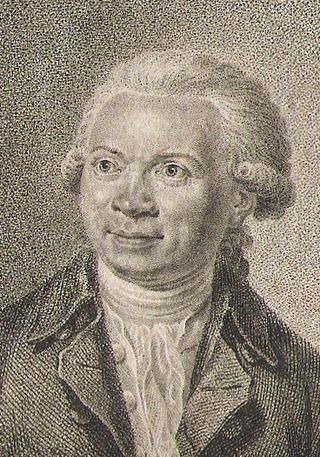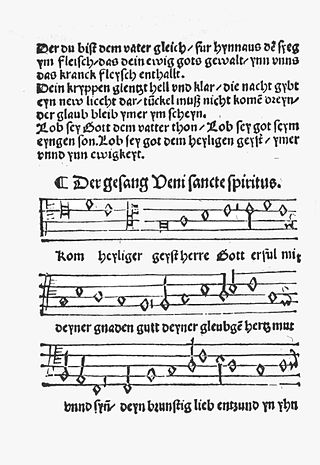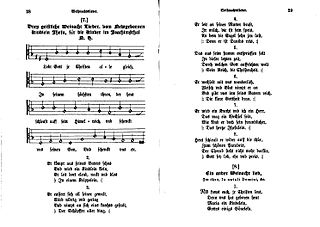
Johann Abraham Peter Schulz was a German musician. He is best known as the composer of the melody for Matthias Claudius's poems "Der Mond ist aufgegangen" and "Wir pflügen und wir streuen", and the Christmas carol "Ihr Kinderlein kommet".
"Ihr Kinderlein, kommet" is a German Christmas carol.
Johannes Christoph Andreas Zahn was a German theologian and musicologist best known for his opus Die Melodien der deutschen evangelischen Kirchenlieder, a critical anthology of almost 9,000 hymn melodies developed and used in German Lutheran churches.

"Aus tiefer Not schrei ich zu dir", originally "Aus tieffer not schrey ich zu dir", later also "Aus tiefer Noth schrei' ich zu dir", is a Lutheran hymn of 1524. Its lyrics were written by Martin Luther as a paraphrase of Psalm 130. It was first published in 1524 as one of eight songs in the first Lutheran hymnal, the Achtliederbuch, which contained four songs by Luther, three by Paul Speratus, and one by Justus Jonas, and also appeared the same year in the Erfurt Enchiridion. It is part of many hymnals, also in translations. The text inspired vocal and organ music from the Renaissance to contemporary, including composers such as Johann Sebastian Bach, who based a chorale cantata on it, Felix Mendelssohn and Max Reger.

"Gelobet seist du, Jesu Christ" is a Lutheran hymn, written by Martin Luther in 1524. It was first published in 1524 in the Eyn geystlich Gesangk Buchleyn. For centuries the chorale has been the prominent hymn (Hauptlied) for Christmas Day in German speaking Lutheranism, but has also been used in different translations internationally. It has appeared in hymnals of various denominations including the Catholic Church.

"Wo Gott der Herr nicht bei uns hält" is a Lutheran hymn by Justus Jonas, a paraphrase of Psalm 124 in eight stanzas. It was first published in 1524 in the Erfurt Enchiridion. The theme of the psalm is the need of help against raging enemies. It has been translated also as "Where the Lord God does not stand (stay) with us", "If God the Lord is not with us", "If God the Lord is not on our side", among others.

The Kreuzschule in Dresden is the oldest surviving school in Dresden and one of the oldest in Germany. As early as 1300, a schoolmaster was mentioned. It was founded as a grammar school for the singers of the capella sanctae crucis, now the Dresdner Kreuzchor. The school is now a Protestant Gymnasium, officially called the Evangelisches Kreuzgymnasium.
"Nun lob, mein Seel, den Herren" is a Lutheran hymn written in German by the theologian and reformer Johann Gramann in 1525. It was published in 1540 and appears in 47 hymnals. A translation by Catherine Winkworth, "My Soul, now Praise thy Maker!", was published in 1863.

"Komm, Heiliger Geist, Herre Gott" is a Lutheran hymn for Pentecost, with words written by Martin Luther based on "Veni Sancte Spiritus, reple tuorum corda fidelium". The hymn in three stanzas was first published in 1524. For centuries the chorale has been the prominent hymn (Hauptlied) for Pentecost in German-speaking Lutheranism. Johann Sebastian Bach used it in several chorale preludes, cantatas and his motet Der Geist hilft unser Schwachheit auf, BWV 226.
"Herzlich lieb hab ich dich, o Herr" is a Lutheran hymn in German by the Protestant theologian and reformer Martin Schalling, written in Amberg in 1569 and first printed in 1571. It is sung to an anonymous melody, Zahn No. 8326, which appeared in a tablature book for organ in 1577. The hymn is often used for funerals, especially the third and last stanza, "Ach Herr, laß dein lieb Engelein". It appears in the current German Protestant hymnal Evangelisches Gesangbuch (EG).

"Vom Himmel hoch, da komm ich her" is a hymn text relating to the Nativity of Jesus, written by Martin Luther in 1534. The hymn is most often sung to the melody, Zahn No. 346, which first appeared in a 1539 songbook and was probably also composed by Luther. This classic Christmas carol remains popular and has inspired many choral and organ works by other composers.

"Mit Fried und Freud ich fahr dahin" is a hymn by Martin Luther, a paraphrase in German of the Nunc dimittis, the canticle of Simeon. Luther wrote the text and melody, Zahn No. 3986, in 1524 and it was first published in the same year. Originally a song for Purification, it has been used for funerals. Luther included it in 1542 in Christliche Geseng ... zum Begrebniss.

Friedrich Heinrich Ranke was a German Protestant theologian. He was the brother of historian Leopold von Ranke (1795–1886) and the father of pediatrician Heinrich von Ranke (1830-1909) and anthropologist Johannes Ranke (1836-1916).

"Heut triumphieret Gottes Sohn" is a Lutheran hymn for Easter. Kaspar Stolzhagen published the hymn in 1592, and its setting by Bartholomäus Gesius was published in 1601. The hymn was adopted in several hymnals, including the Evangelisches Gesangbuch. Composers such as Johann Sebastian Bach based compositions on its hymn tune.

Martin Luther was a great enthusiast for music, and this is why it forms a large part of Lutheran services; in particular, Luther admired the composers Josquin des Prez and Ludwig Senfl and wanted singing in the church to move away from the ars perfecta and towards singing as a Gemeinschaft (community). Lutheran hymns are sometimes known as chorales. Lutheran hymnody is well known for its doctrinal, didactic, and musical richness. Most Lutheran churches are active musically with choirs, handbell choirs, children's choirs, and occasionally change ringing groups that ring bells in a bell tower. Johann Sebastian Bach, a devout Lutheran, composed music for the Lutheran church: more than half of his over 1000 compositions are or contain Lutheran hymns.

"Meinen Jesum laß ich nicht" is a German Lutheran hymn, with lyrics by Christian Keimann written in 1658. The theme of the hymn is trust in Jesus, based on memorial sermons for John George I, Elector of Saxony recalling conversations of the elector with his minister on his deathbed.

"Lobt Gott, ihr Christen alle gleich" is a German Christmas carol with lyrics and melody by Nikolaus Herman. It is part of Protestant and Catholic hymnals, has inspired musical settings, and has been translated. The title is also known as "Lobt Gott, ihr Christen allzugleich".
Events from the year 1832 in Germany.
"Aus der Tiefen rufe ich, Herr, zu dir" is a German hymn with a text by Georg Christoph Schwämlein. The opening lines of the hymn stay close to those of Psalm 130, while most stanzas of the hymn are written from a Christian perspective. It was first published, with its own hymn tune, in the Nürnberg hymnal of 1676. Gottfried Vopelius published it with a new hymn tune in the 1682 Neu Leipziger Gesangbuch, p. 936. From 1699 to 1738 the hymn was published with four more new melodies.
The Evangelische Verlagsanstalt (EVA) is a denominational media company founded in Berlin in 1946. Its shareholders are the Gemeinschaftswerk der Evangelischen Publizistik and the Evangelical-Lutheran Church of Saxony. The managing director is Sebastian Knöfel.













